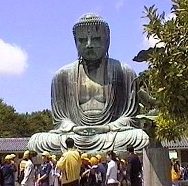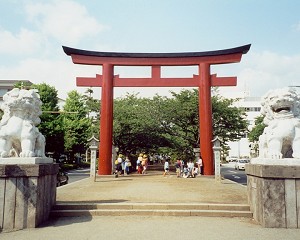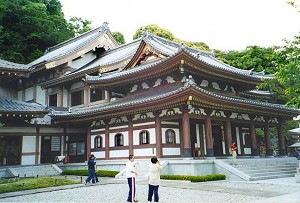
|
|
Such a contrast to Tokyo, very relaxed. Enjoy pleasant
strolls in the narrow side streets,
but be prepared for some serious walking to reach some of the 'off-the-track'
temples. |
| Kotoku-in |
 |
The most famous and popular
sight is
undoubtedly the Daibutsu, the
'Great Buddha', a 37 foot high, bronze statue
that was cast in 1252. This is the second
largest Buddha statue in Japan, the largest
being at Nara's Todaiji temple |
| |

Torii - approach to the Hachiman Shrine
|
Tsurugaoka
Of great historical interest is the Hachiman
Shrine, dedicated to the god of war, the shrine was founded
in 1063 by Minamoto Yoriyoshi. It is the
family shrine of the Minamoto clan and therefore has much to engage
those interested in the warring history of the Heian
period. |
| To one side of the steps leading up
to the main building is a giant ginkgo tree, this marks the spot where
shogun Minamoto Sanetomo was murdered in
1219. Nearby is a small pagoda, the tomb of the first shogun Minamoto
Yoritomo. |
Hasedera
(Hase Kannon Temple)
This fine temple complex sits on a hill
to the west of the city. As well as some
fine views over the bay, there are
many buildings to admire |
 |
| The Kannon Hall, is
home to the celebrated sculpture known as the Hase Kannon, the eleven
faced bodhisattva (Goddess of compassion) Carved from camphor wood,
30' high, it is the largest wooden sculpture in Japan. The Amida
Hall, houses a fine Amida Buddha which was commissioned by
Minamoto Yoritomo. |
| There is a local rail line with a station nearby
to get you back to the centre of town |
Also consider the Zeniarai-Benten
Temple, dedicated to the goddess of good fortune.
Inside a cave you can wash your money in a stream to bring good luck.
And then there's
Myohonji, Jufukuji
and Eishoji..... |
With so many other temples to visit, if as I was
you are only in Kamakura for the day,
a local map and some careful planning is required. As the pace here
is so leisurely you do
need much more than a day to appreciate it. |
|


